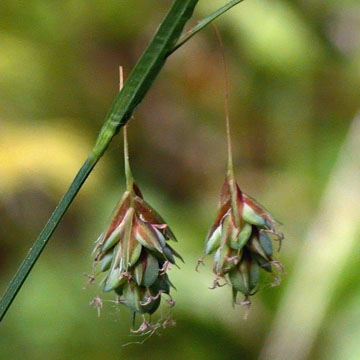

Carex magellanica - (image 1 of 3)
Taxonomy
Family: Cyperaceae
Section Limosae
Synonymous with C. paupercula Michx.
Habitat
Sphagnum bogs, fens, swamps.
Associates
Distribution
North American plants are ssp. irrigua which is circumboreal, ranging south in the northeast to NJ, PA, MI, and MN; also occurs in parts of the west. Typical C. magellanica is a southern hemisphere taxon that occurs in cool temperate areas of South America.
Morphology
Perennial from short or long rhizomes; stems loosely clustered, 20-70 cm, phyllopodic, the remains of old leaves often persistent at the base; roots covered with yellowish-brown tomentum; leaves flat, 1-3 mm wide; terminal spike staminate, 7-15 mm; pistillate spikes 1-4, nodding on slender peduncles, often with a few staminate flowers at the base, the lowest subtended by a more of less sheathless leafy bracts 2-10 cm long; pistillate scales light to dark brown, often with a green midstripe, generally longer and narrower than the perigynia and tapering to a long, narrow point or short awn; perigynia pale, greenish or stramineous, elliptic to ovate, somewhat compressed, 2-ribbed with 4-7 nerves on each face, 2.3-4.2 mm long, beakless or with a minute beak to 0.2 mm; achene trigonous, loosely enveloped.
Notes
Fruiting June to July
Wetland indicator: OBL
In NY this species is most often found in northern white cedar swamps. Carex limosa is similar but has scales that are about as long and as wide as the perigynia.
References
Ball, P.W. and A.A. Reznicek. 2002. Carex, In: Flora of North America Editorial Committee, Eds. Flora of North America North of Mexico. Volume 23. Oxford University Press, New York.
Gleason, Henry A. and A. Cronquist. 1991. Manual of Vascular Plants of
Northeastern United States and Adjacent Canada. Second Ed.
The New York Botanical Garden. Bronx, NY
|
© Michael Hough 2018 |